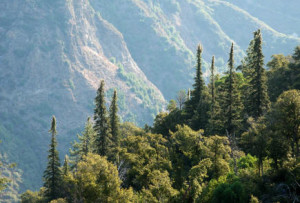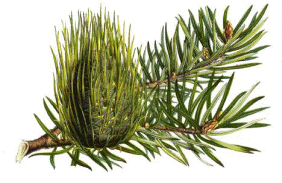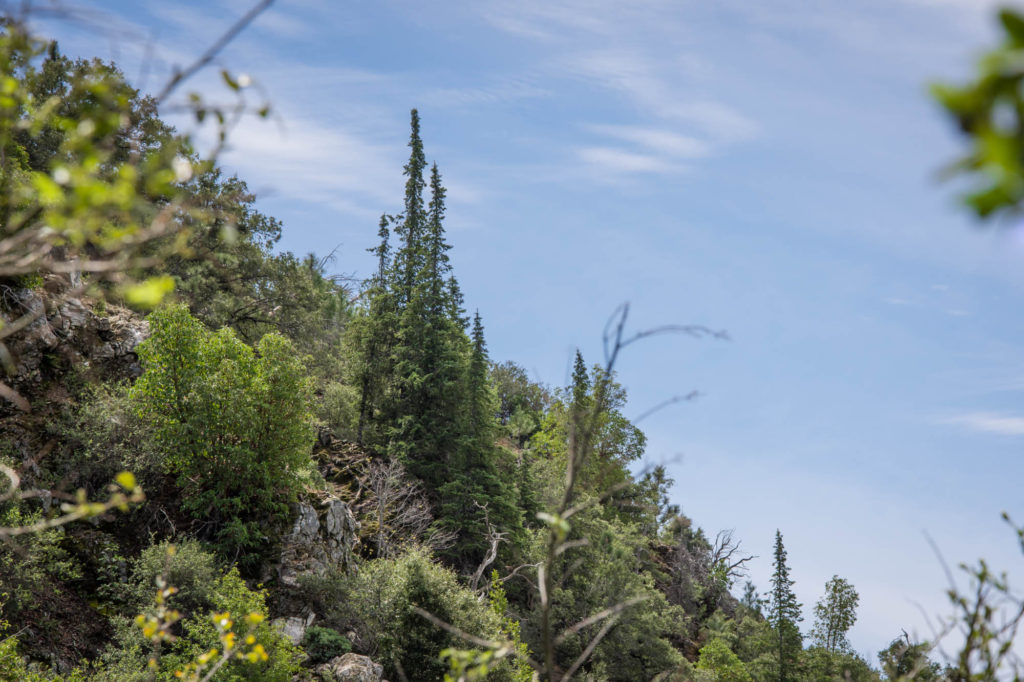Abies bracteata
- Sensitive – U.S. Forest Service
- Rare Plant Rank 1B.3 – California Native Plant Society
- Near Threatened – IUCN Red List
- G2 Imperiled – NatureServe (2017)

Scattered in the Santa Lucia Mountains of the Los Padres National Forest is the rarest and most unusual of all species of fir, the Santa Lucia fir (also known as the bristlecone fir). Found only in the mountains whose name it bears, the Santa Lucia fir is restricted to the upper watersheds of the Carmel, Little Sur, Big Sur, Arroyo Seco, San Antonio and Nacimiento Rivers, and in many smaller watersheds of the Big Sur region — always within 13 miles of the coast. The southern-most documented populations are located near Hearst’s Castle, in northwestern San Luis Obispo County.
Considered the “rebels” of the firs, the Santa Lucia fir has a number of unique characteristics that makes it unmistakable (and almost strange). Needles that are usually short, thick, and soft on firs grow to be two inches long on the Santa Lucia fir and are thin and dagger-tipped (easily piercing your skin if you grab at a branch too carelessly). Its cones are found only in the very top of the tree’s crown, which grow unique long papery bristles, giving them a look like a roosting hedgehog! They also have very narrow and sharply pointed spire-like crowns, which resemble the crowns of fir and spruce species of subalpine and arctic regions.
The tree can grow as tall as 100 feet, and is often found alongside coast redwoods or various species of oaks. It usually grows singly or in small groups. Among fir species of North America, the Santa Lucia fir has the smallest range and is the most rare. While population trends on national forest lands are poorly known, the Santa Lucia fir is not considered to currently be at risk of extinction.

History
The Esselen and Salinan native peoples (in whose traditional territories the species occurs) certainly had their own names for this species, but the padres at Mission San Antonio de Padua were reported to have known the trees as Incensio, for they used its resin in the manufacturing of incense. It wasn’t “officially recorded” until the spring of 1831 when the first botanist, David Douglas, collected a specimen of the species on a ridge west of Mission San Antonio. They are now widely distributed in botanical and private gardens, but for reasons unknown, garden specimens frequently do not exhibit the narrow spire-like crowns typical of the trees of the Santa Lucia Mountains.
Threats

Possibly because of its rarity and preference for steep topography, the Santa Lucia fir has escaped the threat of commercial logging over time. While much of the existing population occurs within the Ventana Wilderness of the Monterey District of the Los Padres National Forest, a new vegetation clearing proposal could impact individuals outside of the wilderness area. The poorly named “Ecological Restoration Project” proposed in 2022 would allow the use of heavy equipment for logging and other vegetation removal activities in areas where the Santa Lucia fir—a species considered “sensitive” by the Forest Service—is known to grow. In fact, analysis of botanical survey data shows that 21% of the official known occurrences of the species are found within the project area. Learn more about the project and how it threatens the Santa Lucia fir and many other rare, sensitive, threatened, and endangered plants and animals in the Los Padres National Forest.
A recently recognized threat is the invasion of nonnative species into the understory. French broom is particularly invasive and difficult to eradicate once established. French broom directly competes with seedlings of Santa Lucia fir. Such invasive plant species can be spread by ground-disturbing activities such as those proposed in the “Ecological Restoration Project.”
Protection Efforts

In addition to the protection afforded to the Santa Lucia Fir through the Ventana Wilderness designation, in 2005 the Los Padres National Forest also established the Ventana Cones Research Natural Area in the heart of the Ventana Wilderness. This 2,200-acre RNA was established to specifically protect the Santa Lucia fir and its associated rock-outcrop vegetation. Unfortunately, the Forest Service has yet to prepare a management plan for the area to ensure the continued protection of Santa Lucia fir.
ForestWatch and partners are currently working to protect the Santa Lucia fir and other species from a massive vegetation clearing project currently proposed in the Los Padres National Forest.






